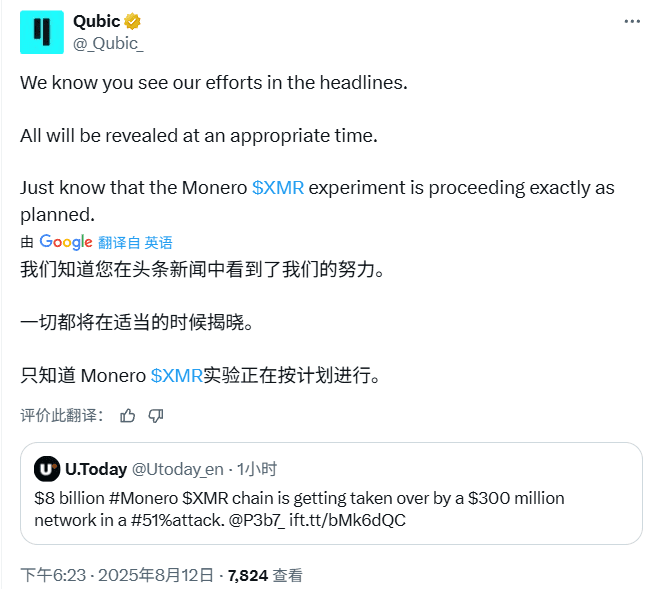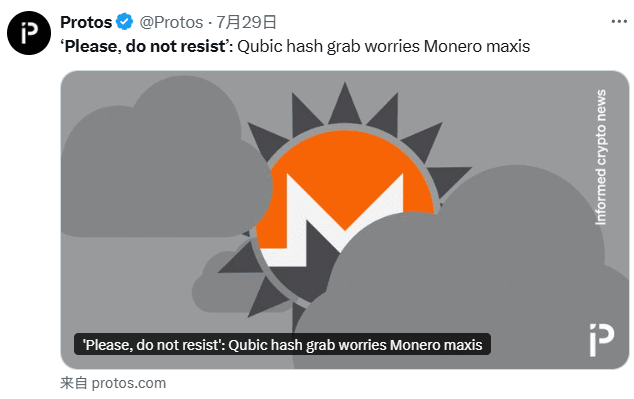Written by: Oliver, Mars Finance
In the ever-evolving narrative of the crypto world, some names seem to have faded from the spotlight. Monero (XMR) is one of them. As a 'living fossil' project that emerged in 2014, it doesn't promise astonishing yields like DeFi protocols nor ignite social media frenzy like NFTs or meme coins. For years, Monero has been like a silent craftsman, focused on its original mission—to create a truly untraceable and unlinkable digital cash system. Its development does not pursue immediate success but rather the continuous refinement of privacy technology and the ongoing strengthening of network resilience.
However, this persistence also puts the entire privacy track on a razor's edge. With the tightening of global regulations, privacy coins have become the 'number one enemy' of compliance. Major exchanges have been delisting them to avoid potential legal risks. From the outside, it seems that the challenges facing the privacy track mainly come from external pressure from regulatory bodies. However, no one expected that a more disruptive crisis would erupt from within the crypto world, targeting the most representative standard-bearer in this track.
On August 12, 2025, the emerging Layer 1 project Qubic released a brief yet information-rich statement on social media: 'The Monero (XMR) experiment is proceeding smoothly as planned, and everything will be revealed at the appropriate time.' This tweet was like a thunderclap, publicly exposing the near-fatal network hash rate crisis that Monero was facing and unabashedly linking itself to this storm. Was this a reckless display of skill, a deliberate attack, or a 'social experiment' aimed at revealing industry ills? To unravel this mystery, we must look towards the orchestrators of the storm.

Behind this storm is a figure who has left a significant mark in the crypto industry—Sergey Ivancheglyo (known in the community as CfB). His name is always associated with disruptive innovation. From his pioneering introduction of pure PoS (Proof of Stake) consensus for the NXT project to later being a core force of IOTA, bringing the groundbreaking technology of 'Directed Acyclic Graph' (DAG) into the public eye, Ivancheglyo's career itself is a history of challenging existing paradigms. His break with the IOTA Foundation and the subsequent public debates surrounding the issue further highlight his inclination to realize his technological vision in a more pure and unrestrained manner outside traditional organizational frameworks. Qubic is a continuation of this style—a latest attempt aimed at fundamentally redefining the value of PoW (Proof of Work).
'Useful' hash power vs. 'economic attack'
Qubic's core concept is 'Useful Proof of Work' (uPoW). Traditional PoW, such as that used by Bitcoin, has miners maintaining network security by solving hash puzzles of no real significance, which is seen as a huge waste of energy. Qubic, however, attempts to make this hash power 'useful', directing it towards AI training, scientific computing, and other fields. Their system allows miners to execute these AI tasks while directing part of their hash power to mine other PoW networks through a mechanism called 'outsourced computing', with Monero being their first target.
The brilliance of this mechanism lies in its creation of a powerful economic incentive. Qubic miners, while receiving their native token QUBIC rewards, can also earn additional profits from Monero mining. More disruptively, Qubic officials sell the mined XMR on the open market, using the proceeds to buy back and destroy QUBIC tokens, creating deflationary pressure that drives up the price of QUBIC. A dangerous flywheel is thus formed: a higher QUBIC price attracts more miners, more miners mean stronger hash power, stronger hash power can mine more XMR, and selling XMR can further push up QUBIC's price.
This is not a traditional hash power attack, but an 'economic attack'. Qubic does not attempt to directly steal funds through double spending attacks, but rather utilizes a superior economic model, like a massive magnet, to attract the originally dispersed Monero hash power to itself. As analyzed by Protos media, this is a 'boiling frog' type of threat that erodes the foundation of Monero’s decentralization.
The siege is on: The Monero community strikes back
When Qubic’s hash rate on the Monero network skyrocketed from 25% in mid-July to a critical point of 48-50% on August 12, the Monero community felt a tangible chill. SlowMist's founder, Yu Xian, confirmed on social media: 'Technically, Qubic's 51% attack on Monero has been successful.' Although Qubic did not initiate a double spending attack, the balance of network security has been thoroughly disrupted.
A 51% attack is the Damocles' sword hanging over PoW chains. Historically, Ethereum Classic (ETC) lost assets worth $1.1 million due to a double spending attack in 2019, while Bitcoin Gold (BTG) suffered losses of up to $18 million in an attack in 2018. The Block quotes estimates from analysts stating that a malicious actor only needs to spend 'between $7,000 to $10,000 per day' to rent enough hash power to control the Monero network. Qubic's 'experiment' has undoubtedly brought this theoretical risk vividly to the forefront.
Faced with the looming crisis, this community, epitomized by 'privacy' and 'anti-censorship', erupted with astonishing cohesion. A grassroots 'hash power defense battle' rapidly ignited. Community members rallied on social platforms like Reddit, calling for all loyal miners to withdraw their hash power from unknown mining pools and redirect it to reputable defensive pools like p2pool (a decentralized mining pool) or supportxmr.com.
The core of this counterattack is to undermine the foundation of Qubic's economic model. Although Sergei Chernykh, the developer of the mainstream mining software XMRig, denied the allegations of launching a DDoS attack on Qubic, he clearly stated that the community is exploring 'completely legal countermeasures'. Behind this is a battle for the soul of the network.
'Please do not resist': Philosophy, arrogance, and the future
In the '172nd Cycle Review' blog post published by Qubic, they recounted the entire process of this 'experiment' in an almost god-like tone, even documenting how they initiated 'selfish mining' to respond to the community’s counterattack. The dramatic climax came when its founder Ivancheglyo responded in the community: 'Please, do not resist.'

This statement is full of provocation but also reveals deeper philosophical reflections behind Qubic's behavior. In the eyes of Ivancheglyo and his supporters, if a PoW network can be easily suppressed by a superior economic system in terms of hash power, then the problem lies within the design of that network; it is 'unfit' in an evolutionary sense. Qubic's 'experiment' serves as a stress test to examine the 'immunity' of PoW networks. They see themselves not as destroyers but as 'whistleblowers' revealing the vulnerabilities that PoW mechanisms may have at the economic incentive level.
This undoubtedly touches upon the core issue of the crypto world: what is the essence of decentralization? Is it the absolute physical dispersion of hash power, or is it a consensus model that can withstand external economic erosion, a more resilient one? Monero’s RandomX algorithm aims to resist ASIC mining machines to achieve fairness in CPU mining; its original intention is to maintain decentralization. However, the emergence of Qubic proves that even if extreme decentralization is achieved at the hardware level, hash power centralization based on economic incentives remains an unavoidable threat.
The impact of this incident is profound. It has sounded the alarm for all PoW projects, especially those with smaller market capitalizations and lower hash rate security barriers. Solely relying on technologically sophisticated designs may not be sufficient to counter the 'dimensionality reduction attacks' from external, more efficient economies. Future public chain competition may not only be a contest of technology and ecosystems but also a game of economic models and incentive mechanisms.
Ultimately, under the tenacious resistance of the Monero community and the immense pressure of public opinion, the hash rate share of Qubic has receded. This war without gunpowder has temporarily come to a close. However, the questions raised by Qubic remain unresolved. It is like a mirror that reflects both the glory and concerns deep within the PoW world. This controversial 'experiment' initiated by a genius developer may not be the last. When the next more powerful 'Qubic' appears, who can guarantee they won’t become the next 'Monero'? This game about hash power, sovereignty, and survival has only just begun.


